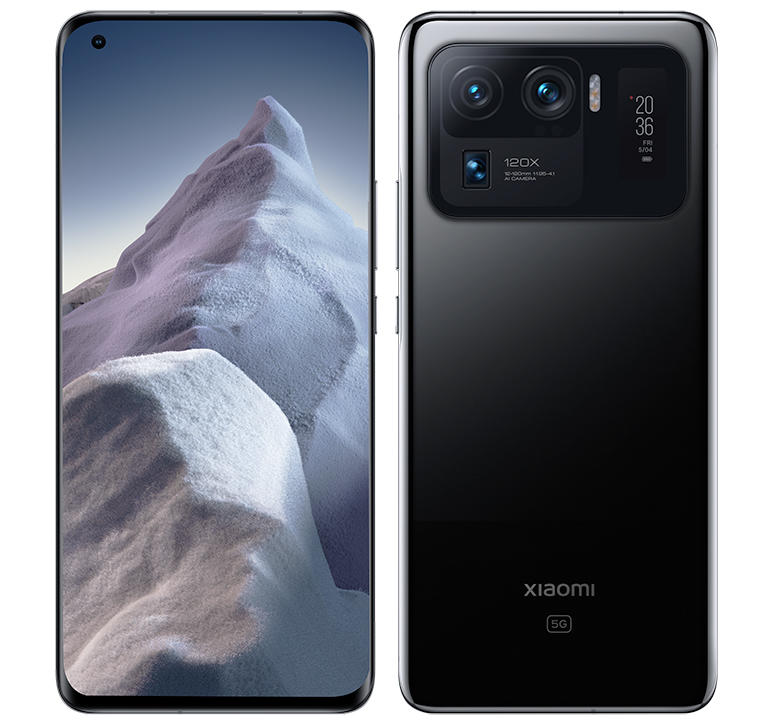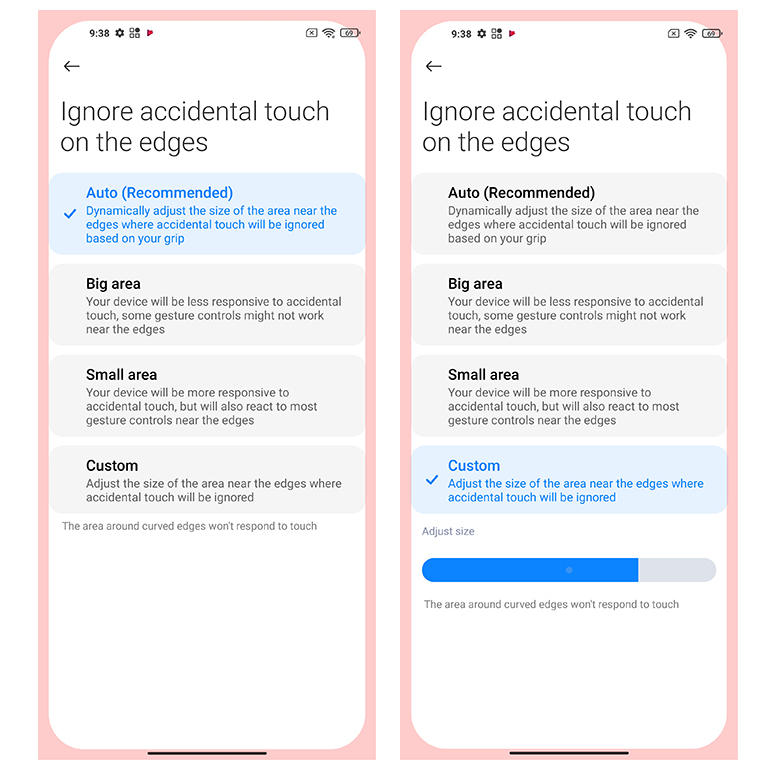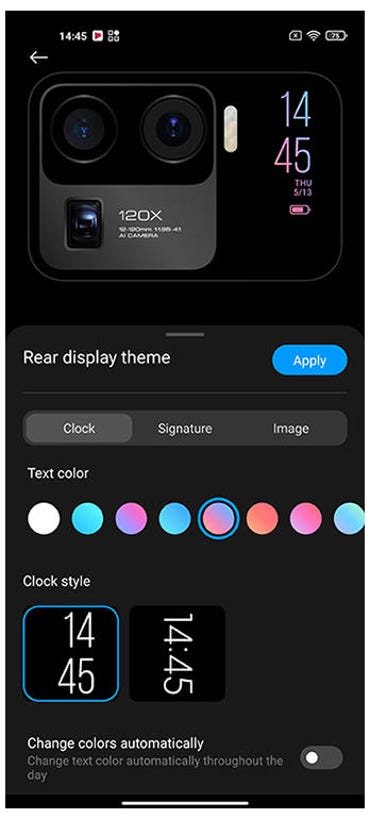Pros
- ✓Excellent build quality
- ✓Top-end Snapdragon 888 5G chipset
- ✓High-resolution 120Hz display
- ✓Fast 67W wired and wireless charging
- ✓IP68 dust/water resistance
Cons
- ✕120x digital zoom disappoints
- ✕Large, heavy and unwieldy
- ✕Second screen at the rear adds little
- ✕Expensive
The Mi 11 Ultra is Xiaomi's new flagship handset. The phone has two underlings, the Mi 11 Lite (£399) and the Mi 11 (from £749), which I reviewed in February. I liked the Mi 11's combination of strong features and attractive price, but here we have an even more lavish specification, and a steeper price of £1,199. On paper, it sounds like a dream -- albeit an expensive one. Standout Mi 11 Ultra features include 120x zoom, 8K video recording, a 5000mAh battery, fast charging, 5G (naturally), and a small second screen on the back.
The specifications make a splash on paper, but the first thing you'll notice when unboxing the Mi 11 Ultra is its 234g weight. You'll also quickly clock the enormous lozenge occupying the upper quarter of the backplate, which houses the camera array and a small second screen (more on both below).
This large protruding rear lozenge makes it a little awkward to hold the phone, and I found the lip was significant enough to snag a jacket pocket, so you need to place the handset snugly with extra care, or deliberately drop it into a pocket upside down. The upside of the camera lozenge occupying all the backplate's width is that the handset doesn't wobble when you prod at the screen with it flat on a desk or table.

Xiaomi Mi 11 Ultra: 6.81-inch AMOLED screen with 120Hz refresh; three cameras and a small second screen at the back; Snapdragon 888 5G chipset with 12GB of RAM and 256GB of (non-expandable) storage.
Images: XiaomiBuild quality is excellent. The rigid aluminium casing is strong, Gorilla Glass Victus provides screen protection, and the ceramic back of my white review unit had a chalky colouring rather than being starkly brilliant white. Unlike the Mi 11, the Ultra model has an IP rating for dust and water resistance: IP68 signifies that it is 'dust tight' and can handle immersion in up to 1.5m of water for up to 30 minutes.
The backplate is very smooth, so of course my 'sofa test' was failed spectacularly: the handset slid off the arm of my sofa almost at will. But it does look stunning, and Xiaomi provides a clear bumper case if you want to have a more assured grip on this £1,000-plus phone. There is a black version for those who find the white model too stark.
Side buttons are kept to a minimum with just the power and volume rocker on the right side. Fingerprint scanning is in-screen, or you can use face login if you prefer. Both worked fine.
Although it's only 8.38mm thick, this is a huge phone, measuring 74.6mm wide and 164.3mm tall. The chassis accommodates a 6.81-inch AMOLED screen with minimal bezels – the screen to body ratio is an impressive 91.2%. The front camera sits unobtrusively in a cut-out in the upper left corner.
It was impossible for me to reach across the screen one-handed, but then smaller screens give me the same problem so that usability factor is not in itself a deal breaker.
The screen's WQHD+ (1440 x 3200 pixels, 515ppi) resolution is, in fact, more of a deal-maker. Everything I did -- reading emails, social media and web pages, and watching video -- was extremely easy on the eye. The handset can automatically switch between full resolution and FHD+ (1800 x 2400) to save on battery power, you can opt for a 120Hz refresh rate for greater clarity, and the screen tops out at an exceptionally bright 1,700 nits. The Mi 11 Ultra's screen has the same specification as that of the Mi 11.

Curved screen edges can result in unwanted touches being registered, hence the number of settings to avoid this.
Images: Sandra Vogel / ZDNetThe long edges of the screen are slightly curved, and you can make settings in software to guard against accidental edge touches if this occurs. It's quite comprehensive – you can even set a custom frame for the screen edges if a wide touch-free area is needed. I found the dynamic, automatically adjusting setting was fine for me and didn't experience any annoying accidental screen presses.

Settings for the Mi 11 Ultra's rear screen.
Image: Sandra Vogel / ZDNetA good screen like this deserves great speakers, but unfortunately that's not what you get here. There are speaker grilles on the top and bottom edges and while they put out plenty of volume, bass tones aren't great and it's far too easy to cover the speakers when holding the phone in landscape mode.
The second screen on the back of this phone is a 1.1-inch rectangle to the right of the camera lenses that can display a range of information: date, time and battery level, a message (the default is a motivational phrase) or an image. The screen goes off after a maximum of 30 seconds, and a tap brings it back to life.
If you're using the rear cameras to take selfies, the second screen acts as a mini-viewfinder, but you need to be pretty close to it to see anything useful. The second screen is an idea with potential, but it doesn't currently offer enough utility to be particularly useful.
The Mi 11 Ultra is a flagship handset, so there's no stinting on internal specifications. It's powered by Qualcomm's top-end Snapdragon 888 5G chipset with 12GB of RAM in support, and the phone absolutely flew through the Geekbench 5 CPU benchmark, returning scores of 1134 (single core) and 3718 (multi core). Among other Snapdragon 888 handsets we've tested, the less expensive Mi 11 with 8GB of RAM was only slightly behind with 1129 and 3704 respectively, while the Oppo Find X3 Pro trailed both Xiaomi handsets with scores of 927 and 3302, despite having 12GB of RAM.
There are two SIM slots in the caddy on the underside of the chassis (this is a 5G handset, of course). There is 256GB of internal storage, with 21GB used out of the box leaving 235GB free. Android 11 and Xiaomi's MIUI 12 overlay take up some of this consumed space. There are plenty of third-party apps, which can be uninstalled, and some Xiaomi apps -- including several that duplicate Android functions -- which can't be. As usual with Xiaomi, the handset is brimming with downloadable themes accessible via an app.

120x digital zoom looks impressive on paper, but is disappointing in reality.
Image: Sandra Vogel / ZDNetThe Xiaomi Mi 11 Ultra has three rear cameras, headed up by a 50MP f/2.0 wide-angle camera with OIS. It's joined by a 48MP f/4.1 telephoto camera with 5x optical, 10x hybrid and 120x digital zoom, and OIS, plus a 48MP f/2.2 ultra-wide-angle (128°) camera. All three rear cameras will capture 8K video at 24 frames per second (fps), with HDR 10 support on the main camera. The front-facing camera is a 20MP f/2.2 unit.
General point-and-shoot photography is very good, as you'd expect with these specifications, but zooming is another matter. The 5x optical zoom is fine, but with every step closer to 120x shots became more and more grainy. I can't think when I'd want to use this 'super-zoom' facility in everyday life. That said, the Mi 11 Ultra currently heads up the DXOMARK smartphone camera rankings, ahead of Huawei's Mate 40 Pro+.
With the Mi 11 Ultra at its maximum 120Hz screen refresh rate during battery testing, the handset's 5000mAh battery managed 12 hours 14 minutes under the PCMark for Android Work 2.0 battery test. It also lost just 16% of a full charge watching three hours of YouTube video at full screen. A day's use should be achievable, but bear in mind that the large 6.81-inch screen is ideal for gaming and video viewing, and regular use of such demanding workloads may mean the battery needs replenishing during the day.
'Turbo' charging, both wired and wireless, is available at 67W, delivering 100% in 36 minutes according to Xiaomi. Unfortunately, I was provided neither with a UK plug to test the out-of-box wired charging experience, or with a wireless charger.
Conclusions
The Xiaomi Mi 11 Ultra is something of a conundrum. As a top-tier handset it ought to knock the rest of Xiaomi's range into a cocked hat, yet in terms of value for money the Mi 11 is a better phone. Both handsets share the same (excellent) screen and (top-end) processor.
The second screen on the back of the Mi 11 Ultra seems unnecessary, and while the cameras do a good job in general, the 120x digital zoom seems like a headline feature that won't be widely used in the real world. Earlier I said that, on paper, this handset seems like a dream -- albeit an expensive one. Sadly, despite its high-end specs and excellent build quality, the Mi 11 Ultra doesn't quite live up to expectations.
RECENT AND RELATED CONTENT
Xiaomi Mi 11 review: Snapdragon 888 chipset, 120Hz OLED screen, 108MP camera, all at a good price
Oppo Find X3 Pro review: Flagship smartphone features at a premium price
Best wireless charger 2021: Easily charge your phone
Read more reviews
"expensive" - Google News
May 18, 2021 at 10:29PM
https://ift.tt/2T2gRaH
Xiaomi Mi 11 Ultra review: Large, powerful and expensive Review - ZDNet
"expensive" - Google News
https://ift.tt/2GwwnlN
Shoes Man Tutorial
Pos News Update
Meme Update
Korean Entertainment News
Japan News Update
Bagikan Berita Ini














0 Response to "Xiaomi Mi 11 Ultra review: Large, powerful and expensive Review - ZDNet"
Post a Comment